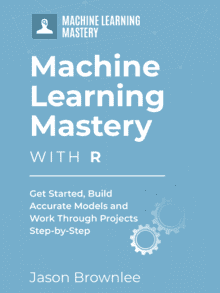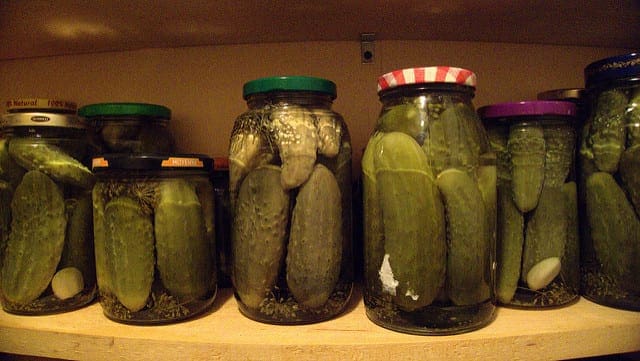Finding an accurate machine learning is not the end of the project.
In this post you will discover how to finalize your machine learning model in R including: making predictions on unseen data, re-building the model from scratch and saving your model for later use.
Kick-start your project with my new book Machine Learning Mastery With R, including step-by-step tutorials and the R source code files for all examples.
Let’s get started.

Finalize Your Machine Learning Model in R.
Photo by Christian Schnettelker, some rights reserved.
Finalize Your Machine Learning Model
Once you have an accurate model on your test harness you are nearly, done. But not yet.
There are still a number of tasks to do to finalize your model. The whole idea of creating an accurate model for your dataset was to make predictions on unseen data.
There are three tasks you may be concerned with:
- Making new predictions on unseen data.
- Creating a standalone model using all training data.
- Saving your model to file for later loading and making predictions on new data.
Once you have finalized your model you are ready to make use of it. You could use the R model directly. You could also discover the key internal representation found by the learning algorithm (like the coefficients in a linear model) and use them in a new implementation of the prediction algorithm on another platform.
In the next section, you will look at how you can finalize your machine learning model in R.
Need more Help with R for Machine Learning?
Take my free 14-day email course and discover how to use R on your project (with sample code).
Click to sign-up and also get a free PDF Ebook version of the course.
Finalize Predictive Model in R
Caret is an excellent tool that you can use to find good or even best machine learning algorithms and parameters for machine learning algorithms.
But what do you do after you have discovered a model that is accurate enough to use?
Once you have found a good model in R, you have three main concerns:
- Making new predictions using your tuned caret model.
- Creating a standalone model using the entire training dataset.
- Saving/Loading a standalone model to file.
This section will step you through how to achieve each of these tasks in R.
1. Make Predictions On New Data
You can make new predictions using a model you have tuned using caret using the predict.train() function.
In the recipe below, the dataset is split into a validation dataset and a training dataset. The validation dataset could just as easily be a new dataset stored in a separate file and loaded as a data frame.
A good model of the data is found using LDA. We can see that caret provides access to the best model from a training run in the finalModel variable.
We can use that model to make predictions by calling predict using the fit from train which will automatically use the final model. We must specify the data one which to make predictions via the newdata argument.
|
1 2 3 4 5 6 7 8 9 10 11 12 13 14 15 16 17 18 19 20 |
# load libraries library(caret) library(mlbench) # load dataset data(PimaIndiansDiabetes) # create 80%/20% for training and validation datasets set.seed(9) validation_index <- createDataPartition(PimaIndiansDiabetes$diabetes, p=0.80, list=FALSE) validation <- PimaIndiansDiabetes[-validation_index,] training <- PimaIndiansDiabetes[validation_index,] # train a model and summarize model set.seed(9) control <- trainControl(method="cv", number=10) fit.lda <- train(diabetes~., data=training, method="lda", metric="Accuracy", trControl=control) print(fit.lda) print(fit.lda$finalModel) # estimate skill on validation dataset set.seed(9) predictions <- predict(fit.lda, newdata=validation) confusionMatrix(predictions, validation$diabetes) |
Running the example, we can see that the estimated accuracy on the training dataset was 76.91%. Using the finalModel in the fit, we can see that the accuracy on the hold out validation dataset was 77.78%, very similar to our estimate.
|
1 2 3 4 5 6 7 8 9 10 11 12 13 14 15 16 17 18 19 20 21 22 23 24 25 26 27 28 29 30 31 32 |
Resampling results Accuracy Kappa Accuracy SD Kappa SD 0.7691169 0.45993 0.06210884 0.1537133 ... Confusion Matrix and Statistics Reference Prediction neg pos neg 85 19 pos 15 34 Accuracy : 0.7778 95% CI : (0.7036, 0.8409) No Information Rate : 0.6536 P-Value [Acc > NIR] : 0.000586 Kappa : 0.5004 Mcnemar's Test P-Value : 0.606905 Sensitivity : 0.8500 Specificity : 0.6415 Pos Pred Value : 0.8173 Neg Pred Value : 0.6939 Prevalence : 0.6536 Detection Rate : 0.5556 Detection Prevalence : 0.6797 Balanced Accuracy : 0.7458 'Positive' Class : neg |
2. Create A Standalone Model
In this example, we have tuned a random forest with 3 different values for mtry and ntree set to 2000. By printing the fit and the finalModel, we can see that the most accurate value for mtry was 2.
Now that we know a good algorithm (random forest) and the good configuration (mtry=2, ntree=2000) we can create the final model directly using all of the training data. We can lookup the “rf” random forest implementation used by caret in the Caret List of Models and note that it is using the randomForest package and in turn the randomForest() function.
The example creates a new model directly and uses it to make predictions on the new data, this case simulated as the verification dataset.
|
1 2 3 4 5 6 7 8 9 10 11 12 13 14 15 16 17 18 19 20 21 22 23 |
# load libraries library(caret) library(mlbench) library(randomForest) # load dataset data(Sonar) set.seed(7) # create 80%/20% for training and validation datasets validation_index <- createDataPartition(Sonar$Class, p=0.80, list=FALSE) validation <- Sonar[-validation_index,] training <- Sonar[validation_index,] # train a model and summarize model set.seed(7) control <- trainControl(method="repeatedcv", number=10, repeats=3) fit.rf <- train(Class~., data=training, method="rf", metric="Accuracy", trControl=control, ntree=2000) print(fit.rf) print(fit.rf$finalModel) # create standalone model using all training data set.seed(7) finalModel <- randomForest(Class~., training, mtry=2, ntree=2000) # make a predictions on "new data" using the final model final_predictions <- predict(finalModel, validation[,1:60]) confusionMatrix(final_predictions, validation$Class) |
We can see that the estimated accuracy of the optimal configuration was 85.07%. We can see that the accuracy of the final standalone model trained on all of the training dataset and predicting for the validation dataset was 82.93%.
|
1 2 3 4 5 6 7 8 9 10 11 12 13 14 15 16 17 18 19 20 21 22 23 24 25 26 27 28 29 30 31 32 33 34 35 36 37 38 39 40 41 42 43 44 45 46 47 48 49 50 51 52 53 54 55 56 57 58 59 60 |
Random Forest 167 samples 60 predictor 2 classes: 'M', 'R' No pre-processing Resampling: Cross-Validated (10 fold, repeated 3 times) Summary of sample sizes: 151, 150, 150, 150, 151, 150, ... Resampling results across tuning parameters: mtry Accuracy Kappa Accuracy SD Kappa SD 2 0.8507353 0.6968343 0.07745360 0.1579125 31 0.8064951 0.6085348 0.09373438 0.1904946 60 0.7927696 0.5813335 0.08768147 0.1780100 Accuracy was used to select the optimal model using the largest value. The final value used for the model was mtry = 2. ... Call: randomForest(x = x, y = y, ntree = 2000, mtry = param$mtry) Type of random forest: classification Number of trees: 2000 No. of variables tried at each split: 2 OOB estimate of error rate: 14.37% Confusion matrix: M R class.error M 83 6 0.06741573 R 18 60 0.23076923 ... Confusion Matrix and Statistics Reference Prediction M R M 20 5 R 2 14 Accuracy : 0.8293 95% CI : (0.6794, 0.9285) No Information Rate : 0.5366 P-Value [Acc > NIR] : 8.511e-05 Kappa : 0.653 Mcnemar's Test P-Value : 0.4497 Sensitivity : 0.9091 Specificity : 0.7368 Pos Pred Value : 0.8000 Neg Pred Value : 0.8750 Prevalence : 0.5366 Detection Rate : 0.4878 Detection Prevalence : 0.6098 Balanced Accuracy : 0.8230 'Positive' Class : M |
Some simpler models, like linear models can output their coefficients. This is useful, because from these, you can implement the simple prediction procedure in your language of choice and use the coefficients to get the same accuracy. This gets more difficult as the complexity of the representation increases.
3. Save and Load Your Model
You can save your best models to a file so that you can load them up later and make predictions.
In this example we split the Sonar dataset into a training dataset and a validation dataset. We take our validation dataset as new data to test our final model. We train the final model using the training dataset and our optimal parameters, then save it to a file called final_model.rds in the local working directory.
The model is serialized. It can be loaded at a later time by calling readRDS() and assigning the object that is loaded (in this case a random forest fit) to a variable name. The loaded random forest is then used to make predictions on new data, in this case the validation dataset.
|
1 2 3 4 5 6 7 8 9 10 11 12 13 14 15 16 17 18 19 20 21 22 23 24 25 26 27 |
# load libraries library(caret) library(mlbench) library(randomForest) library(doMC) registerDoMC(cores=8) # load dataset data(Sonar) set.seed(7) # create 80%/20% for training and validation datasets validation_index <- createDataPartition(Sonar$Class, p=0.80, list=FALSE) validation <- Sonar[-validation_index,] training <- Sonar[validation_index,] # create final standalone model using all training data set.seed(7) final_model <- randomForest(Class~., training, mtry=2, ntree=2000) # save the model to disk saveRDS(final_model, "./final_model.rds") # later... # load the model super_model <- readRDS("./final_model.rds") print(super_model) # make a predictions on "new data" using the final model final_predictions <- predict(super_model, validation[,1:60]) confusionMatrix(final_predictions, validation$Class) |
We can see that the accuracy on the validation dataset was 82.93%.
|
1 2 3 4 5 6 7 8 9 10 11 12 13 14 15 16 17 18 19 20 21 22 23 24 25 |
Confusion Matrix and Statistics Reference Prediction M R M 20 5 R 2 14 Accuracy : 0.8293 95% CI : (0.6794, 0.9285) No Information Rate : 0.5366 P-Value [Acc > NIR] : 8.511e-05 Kappa : 0.653 Mcnemar's Test P-Value : 0.4497 Sensitivity : 0.9091 Specificity : 0.7368 Pos Pred Value : 0.8000 Neg Pred Value : 0.8750 Prevalence : 0.5366 Detection Rate : 0.4878 Detection Prevalence : 0.6098 Balanced Accuracy : 0.8230 'Positive' Class : M |
Summary
In this post you discovered three recipes for working with final predictive models:
- How to make predictions using the best model from caret tuning.
- How to create a standalone model using the parameters found during caret tuning.
- How to save and later load a standalone model and use it to make predictions.
You can work through these recipes to understand them better. You can also use them as a template and copy-and-paste them into your current or next machine learning project.
Next Step
Did you try out these recipes?
- Start your R interactive environment.
- Type or copy-paste the recipes above and try them out.
- Use the built-in help in R to learn more about the functions used.
Do you have a question. Ask it in the comments and I will do my best to answer it.








Hi. I’ve been working through the examples, and some models of my own, and i have a question on preprocessing my data.
When training my models, I used the preProcess argument to center and scale the data.
When I have a new data set to run through my model after training, does the model know to preprocess that data as well? Or do i have to manually scale and center the new data set before applying the model to it? What about after saving and reloading the final model?
this is one of the less-clear points in the docs.
Hi John, great question.
The safest way is to managing data scaling separately and save scaled versions of your data as well as the coefficients needed to scale new data in the future.
According to the caret doco, any preprocessing applied during training will be applied to later calls to predict() on new data:
http://topepo.github.io/caret/model-training-and-tuning.html#preproc
I would expect this to be preserved if you saved the trained model, but I would suggest testing this out (do pre-save and post-save results match for a model with preprocessing).
Are there concerns about applying this to non-classification-problems?
What would be the differences?
No difference of note.
Hm…
Error: Metric Accuracy not applicable for regression models
Error in
[.data.frame(validation, , 1:60) : undefined columns selected1. & 2. fixed, Still getting errors:
Error in confusionMatrix.default(final_predictions, validation$n5) :
the data cannot have more levels than the reference
If I do a print(final_predictions), I get:
3 6 9 11 18 19 21 26 29 39 47 50 61 63 74 92 94 95 97 99 101 104 111 114
M R M R R R M R M R M R R R R R R R R M M R M M
117 120 126 129 137 138 145 146 148 155 160 164 170 171 173 191 206
M M M M M M M M M M M M M R M M M
The last data point has a row index of 206. The original data from Sonar has an end index of 208.
So where is the unseen data here? Are the row indexes in depended from each other?
How to predict one step of unseen data in the future with example 2?
Dear Jason, thanks for the precious post.
I’m going a bit too far maybe, but I’ve been wondering recently if it is possible to save a trained model in some kind of standard format so that it can be (1) sent over a network and (2) parsed even by a different language (I dunno, Java for example).
Are you aware of anything similar, for R or (possibly) other machine learning / statistics suites?
Apologies if the question is considered off-topic.
I believe there are standard model formats, but I am not an expert in them.
See the Predictive Model Markup Language
https://en.wikipedia.org/wiki/Predictive_Model_Markup_Language
Hi Jason – Thanks for the example! This came in very handy and just in time for me.
I’m glad to hear that!
Hi Jason
Great website! Thank you for the very valuable information.
I have a short question concerning the “standalone model”. Why is it necessary to use it after using the caret one? I though bought would be equivalent (i.e. caret using the randomForest one in this example of “rf”-method) and am now a bit confused.
Cheers,
Chris
Caret is a wrapper for the models that can help us find which model to use.
Once we know which model to use, we can use it directly without the caret wrapper – if we want.
Thanks!
Hi Jason,
Excellent work and quite helpful for us who is in learning mode. Just one question here. Suppose, I’ve 100 data-points and I divide into train & test (80 & 20). I fit the model and see accuracy as 75%. My question is how do I implement this model so that when 101st and 102nd data arrives, this model runs and provides me some classification?
I believe this post shows you how to save the model and load it to make predictions on new data.
Perhaps this post will make things clearer:
https://machinelearningmastery.com/train-final-machine-learning-model/
Hi Jason.
The “finalize machine learning models” article above is helpful, and I can’t wait to try it out. However, I notice that it’s making one prediction. Is here a way to get multiple predictions at once, based on criteria, and give them as a list? Like this:
Item 1…result
Item 2…result
Yes, the predict function will support this by default.
Dear Sir,
I am doing dissertation in load balancing in distributed computing system in which I want to predict the future incoming jobs on the basis of past load information given in the real time dataset.So how can I apply this technique in my work?
This might be a good place for you to start:
https://machinelearningmastery.com/start-here/#timeseries
Hello Jason , I have a question, maybe you can help me.
I am using caret, and I need to print the function of a ramdom forest best model, I am talking about all the trees, that are 100.
I know with model$finalModel I can print the function of neuronal network or tree with rpart, but this command don’t print all the trees of random forest or the function of boosted trees
Do you Know how I can do it
Thanks
Sorry, I have not printed all of the trees from a random forest before. Perhaps there is a third party tool to help?
Hey Jason! Thanks for the post. I have a question to you.
I have a built a highly accurate random forest model for a student enrollment prediction project ,let’s say, for this year. Now I have saved the model and want to use this model for data belonging to ,let’s assume, last year. But the number of variables in my last year’s data has changed. How to approach this situation? Is there any way to scale this model to fit the new case?
Thank you!
This process will help you work through your problem systematically:
https://machinelearningmastery.com/start-here/#process
Thanks Jason!
Hello guys! What ML tool (regression model) would be appropriate for predicting call center call volume
This process will help you work through your predictive modeling problem:
https://machinelearningmastery.com/start-here/#process
Hi Jason,
many thanks for this superb post!
Would like to know if the following process (essentially what you did in this post) is considered best practice or common practice in ML and DS:
1. Perform cross-validation to tune hyperparameters
2. using optimised hyperparameters to train the ENTIRE training dataset to arrive at an optimal accuracy?
And also, in part 3 on saving and loading the model, I am encountering problems with the doMC package in R and I understand that doMC is not usable in windows. Could you suggest alternative workaround for this?
Thank you so much
Yes, you can learn more here:
https://machinelearningmastery.com/train-final-machine-learning-model/
The doMC might not be supported on Windows. Perhaps comment it out for now?
Hi Jason,
In the event that you have a large saved model. is there a faster way to read the model. readRDS() takes 5+ secs to read a .rds file of size 51,000 KB.
Thank you so much.
I don’t know, sorry.
Hello. After choosing the best model, how am I loading it and where can I find my results? For example I want to predict the price of an equity tomorrow. How can I load my optimal neural network, how can input the new inputs and where can I find my actual Results?
Thank you
I show how to load the model and make a prediction in the above tutorial.
A very good artical much helpful and I want to ask you one thing regarding deployment of my “R-language – Telecom Churn” prediction model into my production environment) ,I am clear upto saving stand alone program and how to predict on new test data,I joined recently in my job so i want to know about this,could you help me regarding this or please share relevent links about how to consume “Prediction Model” .
I have some suggestions here that might help:
https://machinelearningmastery.com/deploy-machine-learning-model-to-production/
hi jason,
can i use that code for time series data set.
thank you.
Perhaps.
hi jason,
Can you give me some tutorials of your machine learning used in time series data in r.
thank you.
This is a common question that I answer here:
https://machinelearningmastery.com/faq/single-faq/do-you-have-material-on-time-series-in-r
Should we use all training data or all the data (both training and validation) to train the e standalone model ?
Since both training and validation data has the ground “truth” or labels, should we use all the data to train the final standalone model or just the training data? My thought is that we should use all the data with true labels for our final model to predict unknown data. Am I right? Can you please confirm it?
Once you choose a model/config, fit it on all available data with labels.
Hi,
I’ve created a neural net which I’m using to classify text as valid or invalid. It performs really well in the environment I’ve trained it in but when I save the model and take it into a new environement it performs differently. I have given it the same data to predict but the outcome is completely different.
Do you have any idea why this might be?
It sounds like the model has overfit the training data.
This may help:
https://machinelearningmastery.com/introduction-to-regularization-to-reduce-overfitting-and-improve-generalization-error/
Hi Jason, Super helpful tutorial once again!
This worked well for a series of 12 models I developed tested and saved.
However for the xgboost model when I reloaded it for prediction it shows in Rstudio global environment as length 0 size 0 B and got the following error when I tried to run the predict. Error in { : task 1 failed – “object ‘m2predict’ not found”. However the RDS file for this model is showing as 386,450 KB in my hard drive.
I found that there seems to be other functions specific for xgboost (xgb.save?) which is good to know for the future.
Other than retraining the model is there a way to get the existing RDS file with the xgboost model to work or convert it to xgb.save file type?
Thanks in advance for any suggestions!
Hi Jason, Found the underlying bug!
Had nothing to do with the RDS. That seems to be working fine.
Issue was related to variable names from the base models being stacked into the XGBoost.
All good here.
Thanks again for the great tutorials!
Well done, I’m happy to hear that.
Perhaps try running your script from the command line instead of in R studio?
Hi Jason, I have used the clickstream package by R (on parsed log files) , it is a statistical model to predict which link the user is going to click on next.
I’m quite confused about the deployment of the model and its update when new data comes in, I guess as new data comes in the model should be trained with all the data (the new and the old) am I right? so in this case how do I do this?
P.S: I’m new to R and trying to learn data science by myself so any help would be appreciated.
I’m not familiar with that package, sorry.
Normally, a model is fit on available data then deployed for use on making predictions on new data.
Streaming data might be very different and I am not an expert in that area.
Hi Jason,
In your example above, the Sonar data set contains only numeric variables (no factors).
My data set contains both factors and numeric variables. And because of this, the forest saved by “saveRDS” will give an error when the forest is reloaded using “readRDS” to generate predictions.
The error message is “type of predictors in new data do no match that of the training data”. But I am sure and check many times the type are the same.
The error will go away if I convert all variables to numeric, just like your example.
Any suggestions? Thanks.
Some Models may take quite some to be trained. How is the time factor handled when models are implemented in Production?
Thanks in advance.
Models are trained once and then used for prediction.
Retraining a model should be a rare and scheduled event – although depends on the domain and how often it changes enough to require a model update.
Once you train a model and have the confusion matrix, how can you tell which variables have the largest contribution to the model (or the biggest predictive effect)? For example, a regression analysis will tell you which variables are better predictors of the outcome. Is this possible with machine learning models? I think in Python there is a “eli5.show_prediction” function that makes this possible, but I do not know similar functions in R.
Secondly, can we control for dependency in the data when using machine learning? If we have a dataset with three levels (e.g. test scores, within individuals, within schools) can you control for dependency like you can when using multi-level models?
Yes, some models like decision trees will provide a varaible importance scores. Most model do not.
Perhaps. You can choose what you’re modeling, e.g. across test/people/schools.
Hi Jason
Very good article.
What if I want to see the predictive results in the form of csv?
So, I can compare actual data with prediction data row by row.
Please help. Thank you.
Thanks.
You can make a prediction then save the prediction to CSV file.
i did, however the csv file only save the ID and prediction value which i think only have in “predict”. How can i save together with the other variables in the test file?
Yes, create a new matrix or data frame and save that to file. If this is new to you, you might have to check the documentation.
Excellent work Jason.
I have several Caret trained models, and when saved (saveRDS, compressed) they are 100-200+ MB. I am now deploying these to Shiny and they take forever to load and often fail.
Is there a way to make the models smaller or better yet, is there a predict function that allows me to pass in the method and parameters only without all the training\pre-process\sample data?
Wow, they are big models!
Perhaps the models are saving the entire training dataset as well, you could check the object or the API and see if this is the case and then clear it.
In some cases, usung/writing the predict function directly with learned coefficients (such as regression model) can be very effective.